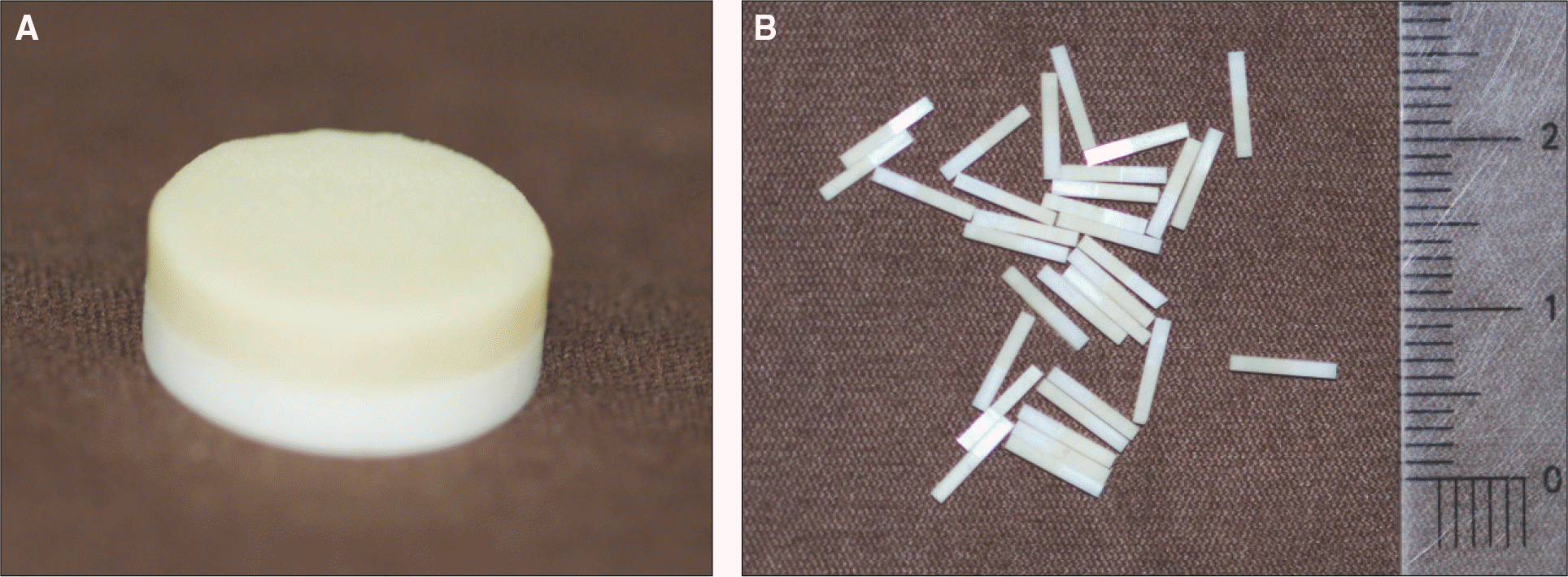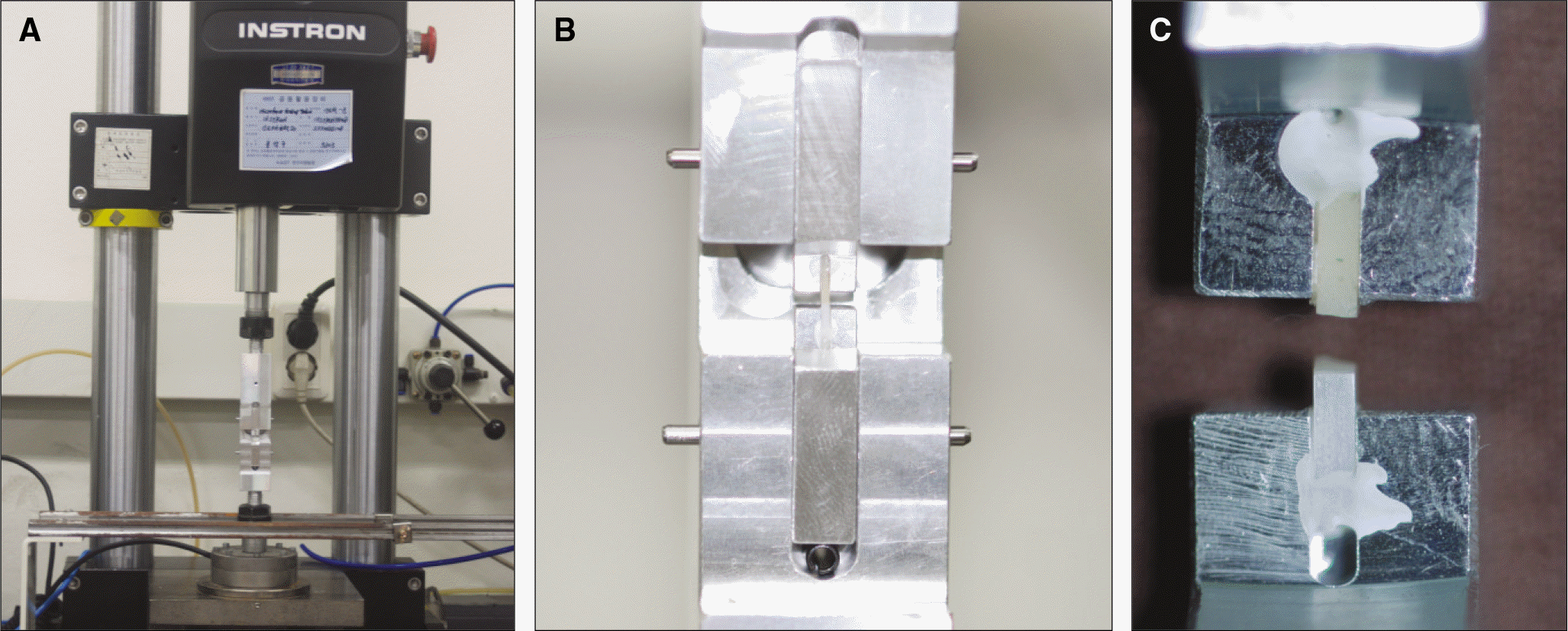Abstract
Purpose
The aim of this study was to investigate effect of specimen preparation method on the microtensile bond strength of veneering ceramic to zirconia core.
Materials and methods
Cylindrical Lava zirconia block (3M ESPE, Seefeld, Germany) was cut into discs using a diamond disc. After sintering, the core specimens were placed in an adjustable mold and veneered with Lava ceram (3M ESPE, Seefeld, Germany). The disc shaped specimen of group 1 was cut into microbars (1×1×7 mm3) using a low speed diamond disc under water cooling (n = 15). The specimen of group 2 was cut into microbars (1.2×1.2×7 mm3) in the same way. Whereafter the microbars were trimmed (1×1×7 mm3) using a thick diamond disc under water cooling (n = 15). The microtensile bond strength was tested in a microtensile tester (Instron 8848, Instron® Co., Norwood, USA). Fractured microtensile specimens were analyzed under a stereomicroscope (MZ6, Leica Microsystems GmbH, Wetzlar, Germany) at magnification ×30.
Go to : 
REFERENCES
1.Manicone PF., Rossi Iommetti P., Raffaelli L. An overview of zirconia ceramics: basic properties and clinical applications. J Dent. 2007. 35:819–26.

2.Vult von Steyern P., Carlson P., Nilner K. All-ceramic fixed partial dentures designed according to the DC-Zirkon technique. A 2-year clinical study. J Oral Rehabil. 2005. 32:180–7.
3.Raigrodski AJ., Chiche GJ., Potiket N., Hochstedler JL., Mohamed SE., Billiot S., Mercante DE. The efficacy of posterior three-unit zirconium-oxide-based ceramic fixed partial dental prostheses: a prospective clinical pilot study. J Prosthet Dent. 2006. 96:237–44.

4.Sailer I., Fehe′r A., Filser F., Lu¨thy H., Gauckler LJ., Scha¨rer P., Franz Ha¨mmerle CH. Prospective clinical study of zirconia posterior fixed partial dentures: 3-year follow-up. Quintessence Int. 2006. 37:685–93.
5.Aboushelib MN., de Jager N., Kleverlaan CJ., Feilzer AJ. Microtensile bond strength of different components of core veneered all-ceramic restorations. Dent Mater. 2005. 21:984–91.

6.Al-Dohan HM., Yaman P., Dennison JB., Razzoog ME., Lang BR. Shear strength of core-veneer interface in bi-layered ceramics. J Prosthet Dent. 2004. 91:349–55.

7.Kelly JR., Tesk JA., Sorensen JA. Failure of all-ceramic fixed partial dentures in vitro and in vivo: analysis and modeling. J Dent Res. 1995. 74:1253–8.

8.Isgro` G., Pallav P., van der Zel JM., Feilzer AJ. The influence of the veneering porcelain and different surface treatments on the biaxial flexural strength of a heat-pressed ceramic. J Prosthet Dent. 2003. 90:465–73.
9.al-Shehri SA., Mohammed H., Wilson CA. Influence of lamination on the flexural strength of a dental castable glass ceramic. J Prosthet Dent. 1996. 76:23–8.

10.Della Bona A., van Noort R. Shear vs. tensile bond strength of resin composite bonded to ceramic. J Dent Res. 1995. 74:1591–6.

11.Sano H., Ciucchi B., Matthews WG., Pashley DH. Tensile properties of mineralized and demineralized human and bovine dentin. J Dent Res. 1994. 73:1205–11.

12.Van Noort R., Cardew GE., Howard IC., Noroozi S. The effect of local interfacial geometry on the measurement of the tensile bond strength to dentin. J Dent Res. 1991. 70:889–93.

13.Cardoso PE., Braga RR., Carrilho MR. Evaluation of microtensile, shear and tensile tests determining the bond strength of three adhesive systems. Dent Mater. 1998. 14:394–8.

14.Valandro LF., Ozcan M., Amaral R., Vanderlei A., Bottino MA. Effect of testing methods on the bond strength of resin to zirconia-alumina ceramic: microtensile versus shear test. Dent Mater J. 2008. 27:849–55.
15.Reis A., de Oliveira Bauer Jr., Loguercio AD. Influence of crosshead speed on resin-dentin microtensile bond strength. J Adhes Dent. 2004. 6:275–8.
16.Yamaguchi K., Miyazaki M., Takamizawa T., Tsubota K., Rikuta A. Influence of crosshead speed on microtensile bond strength of two-step adhesive systems. Dent Mater. 2006. 22:420–5.

17.Sano H., Shono T., Sonoda H., Takatsu T., Ciucchi B., Carvalho R., Pashley DH. Relationship between surface area for adhesion and tensile bond strength-evaluation of a microtensile bond test. Dent Mater. 1994. 10:236–40.
18.Phrukkanon S., Burrow MF., Tyas MJ. Effect of cross-sectional surface area on bond strengths between resin and dentin. Dent Mater. 1998. 14:120–8.

19.El Zohairy AA., de Gee AJ., de Jager N., van Ruijven LJ., Feilzer AJ. The influence of specimen attachment and dimension on microtensile strength. J Dent Res. 2004. 83:420–4.

20.Goracci C., Sadek FT., Monticelli F., Cardoso PE., Ferrari M. Influence of substrate, shape, and thickness on microtensile specimens' structural integrity and their measured bond strengths. Dent Mater. 2004. 20:643–54.

21.Poitevin A., De Munck J., Van Landuyt K., Coutinho E., Peumans M., Lambrechts P., Van Meerbeek B. Influence of three specimen fixation modes on the microtensile bond strength of adhesives to dentin. Dent Mater J. 2007. 26:694–9.

22.Kosmac T., Oblak C., Jevnikar P., Funduk N., Marion L. The effect of surface grinding and sandblasting on flexural strength and reliability of Y-TZP zirconia ceramic. Dent Mater. 1999. 15:426–33.
Go to : 
 | Fig. 1.Veneered zirconia disc (A) was cut into microbars (B) for conducting microtensile bond strength test. |
 | Fig. 2.Microtensile bond strength test. A: microtensile tester, B: before the test, C: after the test. |
Table 1.
Microtensile bond strength value (MPa) of veneering ceramic to zirconia core
Table 2.
Failure type was classified into two groups: cohesive failure in the Lava ceram and mixed failure∗
| Group 1 | Group 2 | |
|---|---|---|
| Failure type | 93% ceramic cohesive | 47% ceramic cohesive |
| 7% mixed | 53% mixed |




 PDF
PDF ePub
ePub Citation
Citation Print
Print


 XML Download
XML Download